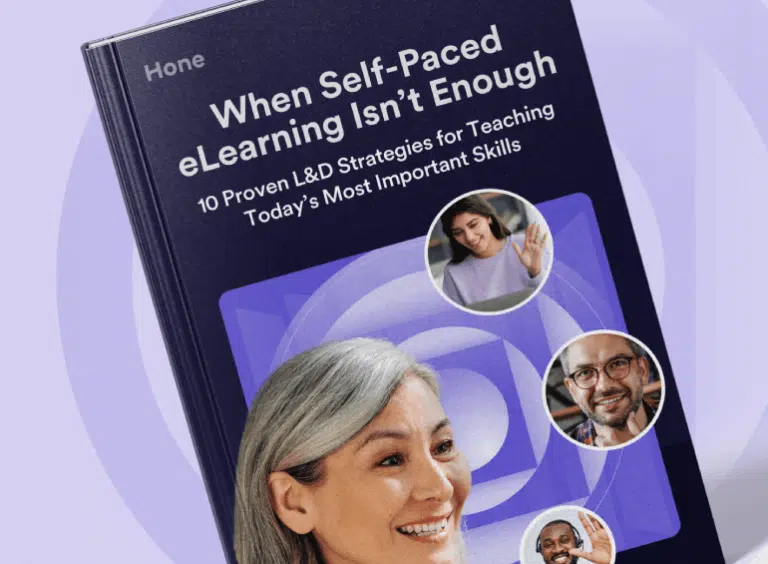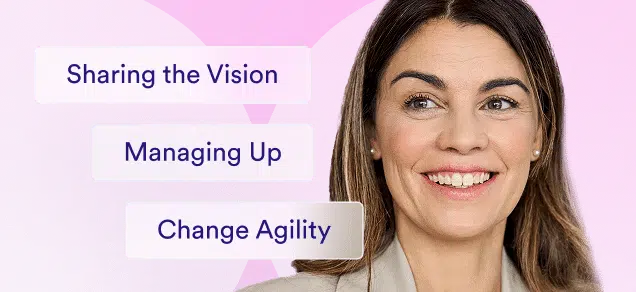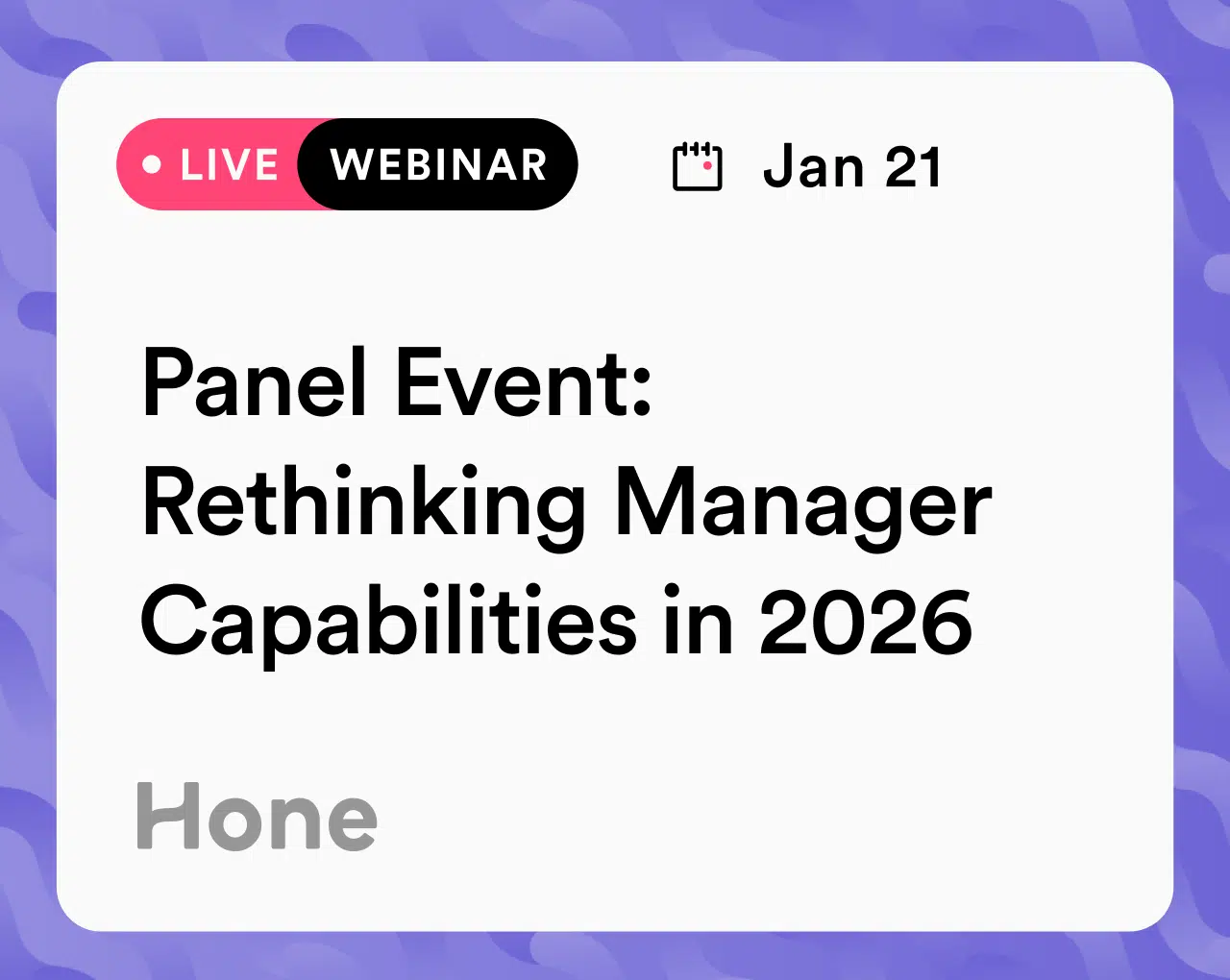When Self-Paced eLearning Isn’t Enough:
10 Proven L&D Strategies for Teaching Today’s Most Important Skills

The importance of collaboration and human interaction in the digital age
There are no islands in a modern organization. For people who work together in teams, the majority of skills that enable them to do their jobs well involve either:
- Interacting with teammates
- Interacting with customers
- Or both
So, to upskill people in your organization on how to more effectively navigate the many critical human interactions that make up their work, there’s one ingredient in particular that you would not want to skimp on: human interaction.
And yet, as reported in the latest ATD State of the Industry, live, collaborative learning has been on the decline since even before the pandemic:
The use of self-paced elearning rose 18% between 2018 and 2019 and has risen another 15% since 2019.
This is amid an overall drop in learning hours, with 2022 seeing the lowest rates of learning per employee since 2014.
We do not intend to claim that self-paced elements play no role in effective learning programs. On the contrary, research shows that the best results come from blended approaches. But there is a rising trend of employees who receive mostly, or even only, elearning, missing out on several important benefits:
Typically, these benefits are offset by two major costs:
But the pandemic-driven rise in distributed work forced many organizations to try live virtual instruction for the first time. What they found is that by eliminating the costs of:
- A training facility
- Accommodations (for learners and/or facilitators)
- Travel (for learners and/or facilitators)
- Time spent not working while traveling
…they could afford to scale live, collaborative learning to more of their teams. Running more sessions also meant more scheduling flexibility — more people could join classes at convenient times or easily make-up classes that they missed. And the results? …No one really measured them.
Just Kidding: After delivering 100,000+ learning hours to 300,000+ learners, here’s what we’ve measured at Hone thus far:
NPS (vs. -8 Average for L&D) and 4.7/5 average session rating.
of learners complete their program (typically four 60 minute live classes).
of learners exhibit performance improvement in 1+ skills (as assessed by colleagues)

What is collaborative learning?
Collaborative learning refers to the practice of people learning together, either co-constructing new knowledge or learning from each other.
Roger and David Johnson defined the five essential elements of cooperative learning, a specific version of collaborative learning that includes a common goal learners are working toward. The elements are:
The five essential elements of cooperative learning
Positive interdependence
Getting learners to depend on each other, for example, through group exercises that rely on each member fulfilling their part
Individual and group accountability
Expecting learners to have their cameras on and participate fully in each individual and group activity
Promotive interaction
Getting learners to discuss concepts, do group work, etc. in an encouraging and supportive way, especially while able to see other’s faces
Use of social skills
Requiring that learners ask questions of each other, give each other feedback, or otherwise collaborate using social skills
Group processing
Discussion among the group about how well they are working together and achieving their goals
Get the full guide
Learn how to put Hone’s proven collaborative learning strategies into practice in your organization.
Now let’s explore the three major benefits of collaborative learning:

Realistic Practice for Skills of Human Interaction
Collaborative learning techniques like coaching, role playing, and giving feedback can be employed much more easily and effectively in a live setting than asynchronously.
For learners working on “human interaction” skills (i.e., people skills, soft skills, etc.), realistic practice means interacting with one or more people in a live learning environment, whether in person or virtual. In other words, when the target of learning falls under the umbrella of human interaction, collaborative learning doubles as realistic practice.

Motivation for Behavior Change
Learners placed into a classroom with their peers are likely to experience:
- Shared accountability
- Social comparison
- Inforamtion about other
- Emotional support
The content of each learning experience should have a clear answer to the question of “What’s in it for me?” But often, simply stating that to a learner is not enough to motivate full engagement and effort. Collaborative learning naturally unlocks the above behavior change techniques, which can help break through skepticism and disinterest and get an entire group buzzing with motivation.

Psychological Safety at Scale
As our lives become increasingly mediated by technology, with workspaces where face-to-face interactions are the exception rather than the rule, live experiences become increasingly invaluable.
Live virtual allows you to scale collaborative learning experiences, and learners benefit greatly from this scale.
When everyone can see and hear each other admitting to challenges or weaknesses, and also sharing their goals and aspirations, it sends the message that everyone has something to learn, and that everyone cares about each other’s growth and success.
The result is a strong foundation of psychological safety — a belief that you can take risks around your team members — one that powers high-performing teams as well as entire cultures of continuous learning.

10 proven collaborative learning strategies for teaching today’s most important skills
The following best practices describe ways of boosting attendance, engagement, skill-building, and application in live virtual learning programs, but most of the lessons also apply to other delivery mechanisms. After teaching hundreds of thousands of learners, we have seen these strategies contribute to better learning outcomes firsthand.
Attendance
1 . Mandate enrollment, but offer lots of flexibility
2 . Get executive sponsors to sell the benefits of the program
3 . Launch training to multiple audiences around a shared moment of need
Engagement
4 . Set expectations that active participation by everyone is the norm
5 . Follow Mayer’s Multimedia Principles
6 . Keep sessions between 30 minutes and 2 hours
Skill building
7 . Start with direct instruction and then fade guidance
8 . Facilitate independent practice – or even better – actual work
9 . Use breakouts to achieve multiple goals
Application
10 . Have learners make commitments during class

Get the full guide
Learn how to put Hone’s collaborative learning strategies into practice in your organization.







